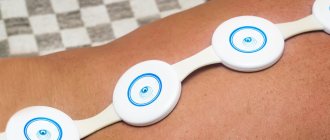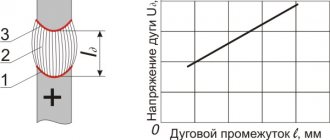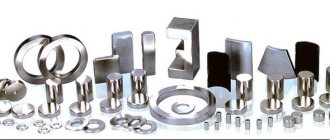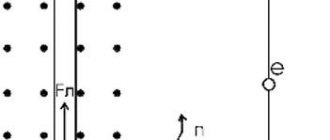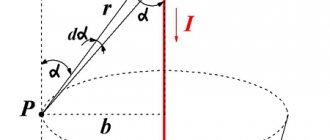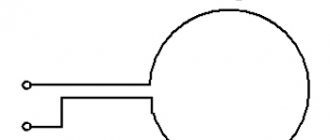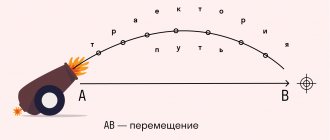Home > Theory > Permanent magnets
There are two main types of magnets: permanent and electromagnets. You can determine what a permanent magnet is based on its main properties. A permanent magnet gets its name because its magnetism is always “on.” It generates its own magnetic field, unlike an electromagnet, which is made of wire wrapped around an iron core and requires current to flow to create a magnetic field.
Permanent magnet
History of the study of magnetic properties
Centuries ago, people discovered that some types of rocks have an original property: they are attracted to iron objects. Mention of magnetite is found in ancient historical chronicles: more than two thousand years ago in European and much earlier in East Asian. At first it was regarded as a curious object.
Later, magnetite was used for navigation, finding that it tends to occupy a certain position when given the freedom to rotate. Scientific research carried out by P. Peregrine in the 13th century showed that steel could acquire these characteristics after being rubbed with magnetite.
Magnetized objects had two poles: “north” and “south,” relative to the Earth’s magnetic field. As Peregrine discovered, isolating one of the poles was not possible by cutting a fragment of magnetite in two - each individual fragment ended up with its own pair of poles.
In accordance with today's concepts, the magnetic field of permanent magnets is the resulting orientation of electrons in a single direction. Only some types of materials interact with magnetic fields; a much smaller number of them are capable of maintaining a constant magnetic field.
Properties of permanent magnets
Powerful magnets
The main properties of permanent magnets and the field they create are:
- the existence of two poles;
- opposite poles attract, and like poles repel (like positive and negative charges);
- magnetic force imperceptibly spreads in space and passes through objects (paper, wood);
- An increase in MF intensity is observed near the poles.
Interaction of magnetic poles
Permanent magnets support the MP without external assistance. Depending on their magnetic properties, materials are divided into main types:
- ferromagnets – easily magnetized;
- paramagnetic materials – are magnetized with great difficulty;
- Diamagnets - tend to reflect external magnetic fields by magnetizing in the opposite direction.
Important! Soft magnetic materials such as steel conduct magnetism when attached to a magnet, but this stops when it is removed. Permanent magnets are made from hard magnetic materials.
Use of magnets in everyday life
A special feature of the magnet is a sharp decrease in power already at a short distance from its surface. This gives the product two valuable properties at once: metal objects are firmly fixed on it and can be easily removed with little effort. Therefore, a magnet is indispensable for organizing space: tools, knives, kitchen utensils are located on magnetic mounts securely and conveniently. Even non-magnetic materials can be attached to them: just put a spring from a pen on a copper wire, and the cord from the charger will always be at hand. Just glue a series of small plates to the bottom surface of a kitchen cabinet or refrigerator shelf - and you have an excellent organizer for containers with metal lids: spice jars, baby food or beer bottles.
Moreover, even small magnets have great strength and are therefore very convenient to use. Tired of looking for a pen and notepad? Place or glue a tiny magnet inside and they will take their place on the refrigerator door once and for all. Fasteners for bags and wallets, money clips, fastenings for lighters, needles, pins and other small jewelry are easily and quickly made using a magnet. And if you put it inside the plastic switch housing in the hallway, you can attach keys that are always lost to it, and at the same time get rid of painful thoughts: is the electricity in the house turned off?
But magnets are especially in demand during repairs. A container with a magnet will retain all small fasteners when disassembling household appliances. A magnetic strip on a screwdriver is suitable for fixing bits and screws, and a magnet placed in a bracelet or breast pocket of a shirt is a great way to keep screws, nuts and other hardware at hand. And it’s also good for health—magnetic therapy is held in high esteem by doctors. By the way, if small metal items do fall apart, turn the cardboard or plastic box over, attach a magnet to the bottom, collect what was lost, and then simply remove the magnet. This is such everyday magic.
The force of attraction can be easily adjusted by changing the size of the magnet or the number of its elements. A solid or composite powerful magnet is a reliable means of grounding the welding machine and searching for hidden embedded elements in walls and ceilings: before drilling, be sure to check where the pipes, fittings and corners go. And fixing the metal before welding is faster and easier with a strong magnet. Magnetic clamps for gluing parts of complex shapes, magnetizing a tool for holding hardware, a magnetic filter for cleaning technical fluids from metal shavings are just a few examples of the indispensability of a simple device.
Another area of application for magnets is road travel. Fix the funnel in the gas tank when refueling from a canister, conveniently position the tool during repairs, install foil protection from the sun's rays, pull up an awning or a rope for drying towels - perhaps there are simply no other ways to attach to the metal of the case without the risk of damaging the paintwork. Magnets will also come in handy when arranging everyday life: the edges of the anti-mosquito canopy pressed with them will reliably block access to bloodworms, and if you bury a beer cap in a bar of soap, you’ll have a magnetic soap dish.
How does a permanent magnet work?
His work deals with atomic structure. All ferromagnets create a natural, albeit weak, magnetic field, thanks to the electrons surrounding the nuclei of atoms. These groups of atoms are able to orient themselves in the same direction and are called magnetic domains. Each domain has two poles: north and south. When a ferromagnetic material is not magnetized, its regions are oriented in random directions, and their magnetic fields cancel each other out.
To create permanent magnets, ferromagnets are heated at very high temperatures and exposed to strong external magnetic fields. This leads to the fact that individual magnetic domains inside the material begin to orient themselves in the direction of the external magnetic field until all domains are aligned, reaching the point of magnetic saturation. The material is then cooled and the aligned domains are locked into position. Once the external MF is removed, hard magnetic materials will retain most of their domains, creating a permanent magnet.
Production of permanent magnets
Physical mechanism of permanent magnetization
To explain the functioning of a permanent magnet, we must look inside it down to the atomic scale. Each atom has a set of spins of its electrons, which together form its magnetic moment. For our purposes, we can consider each atom as a small bar magnet. When a permanent magnet is demagnetized (either by heating it to a high temperature or by an external magnetic field), each atomic moment is oriented randomly (see figure below) and no regularity is observed.
When it is magnetized in a strong magnetic field, all atomic moments are oriented in the direction of the field and, as it were, interlocked with each other (see figure below). This coupling allows the permanent magnet field to be maintained when the external field is removed, and also resists demagnetization when its direction is changed. A measure of the cohesive force of atomic moments is the magnitude of the coercive force of the magnet. More on this later.
In a more in-depth presentation of the magnetization mechanism, one does not operate with the concepts of atomic moments, but uses ideas about miniature (of the order of 0.001 cm) regions inside the magnet, which initially have permanent magnetization, but are randomly oriented in the absence of an external field, so that a strict reader, if desired, can attribute the above physical The mechanism is not related to the magnet as a whole. but to its separate domain.
Characteristics of permanent magnet
- Magnetic force is characterized by residual magnetic induction. Designated Br. This is the force that remains after the disappearance of the external MP. Measured in tests (T) or gauss (G);
- Coercivity or resistance to demagnetization - Ns. Measured in A/m. Shows what the external MF intensity should be in order to demagnetize the material;
- Maximum energy – BHmax. Calculated by multiplying the remanent magnetic force Br and coercivity Hc. Measured in MGSE (megaussersted);
- Temperature coefficient of residual magnetic force – Тс of Br. Characterizes the dependence of Br on the temperature value;
- Tmax – the highest temperature value, upon reaching which permanent magnets lose their properties with the possibility of reverse recovery;
- Tcur is the highest temperature value at which the magnetic material irreversibly loses its properties. This indicator is called the Curie temperature.
Magnetic flux formula
Individual magnet characteristics change depending on temperature. At different temperatures, different types of magnetic materials perform differently.
Important! All permanent magnets lose a percentage of their magnetism as the temperature rises, but at different rates depending on their type.
Magnets and magnetic fields
2022. Mini-reference books.
• Modern types of permanent magnets, their parameters. • Application of tape recorders in medicine. • Determining the polarity of the magnet (using a compass). • Magnetization of water. • Maximum permissible magnetic field levels. • Electrical fuses • Replacement of electric meters (accuracy 2.5 to 2.0) • Table of electrical resistivities (in microohms, mini-reference book).
The natural magnetic field of the Earth, on its daytime surface, in the middle latitudes of the European part of Russia, has a total vector value of approximately 0.05 mT (induction, in millitesla) = 50 μT (microtesla) = 50 × 10-6 T (Tesla), which is old GHS units are 0.5 Gauss. The field strength, at fifty microteslas, is 40 A/m (amps per meter). Since the first millennium AD, the magnitude of the earth's geomagnetic field has decreased by more than half and the human body is experiencing deficiency syndromes (magnetic deficiency), which can be replenished thanks to magnetic therapy using external sources of the magnetic field.
Fig.1 Earth's magnetic field lines.
The force lines of the normal magnetic field of the planet are directed north and down (they enter the earth almost vertically, at an angle of the order of I = 70°, with a slight declination of ten degrees to the east; this is in the Moscow region, and in other areas of the country – geomagnetic field parameters may differ).
The approximate declination angle can be seen on the map. Accurate, current field parameters are determined using special computer programs. Specialized websites have online calculators and reference data. Links (remove spaces): https:// geomag.nrcan.gc.ca/calc/mfcal-en.php – calculator for calculating components (there, in the calculation results, a comma is the thousandths separator, i.e. the order of magnitude of horizontal and vertical components – thousands and tens of thousands of nanotesla). https:// www.ngdc.noaa.gov/geomag/data/poles/ pole_locations.txt – this web page contains historical information about the displacement of the planet’s magnetic poles, in the form of a list of coordinates, from 1590 to the present).
The main angular elements of the field: D (magnetic declination) – the angle of magnetic declination from the geographic meridian (to the east – positive values). I (magnetic inclination) – the angle of inclination of the total vector of the geomagnetic field, relative to the horizontal.
// Ratio of values: 0.05 mT (magnetic induction in SI units) = 0.5 Gauss (magnetic induction in SGS units - extra-systemic) = 0.5 Oersted (field strength in SGS units)
1 mT = 0.8 kA/m (kiloampere per meter) 1 T = 800 kA/m 1000 kA/m = 1.25 T (Tesla)
Table 1 Modern types of permanent magnets and their approximate characteristics (induction values on their pole surface, maximum operating temperatures, etc.): • Magnets with polymer filling, elastic magnetoretors used in medicine Br = up to 0.05 Tesla (50 millitesla = 500 Gauss).
• Magnetic plastics based on filler (for example, anisotropic NdFeB powder). They can be machined due to their plasticity (like rubber) and the ability to produce complex shapes using injection molding (including mounting holes and fastening means). They do not heat up when operating in alternating electromagnetic fields (insensitive to the effects of eddy currents). The maximum operating temperature is up to 120-220 degrees Celsius, depending on the heat resistance of the binder material. Br = 0.5 – 0.6 T (5000 – 6000 Gauss) (Nd-Fe-B).
• Ferrites (pressed ceramic ferrite-barium and ferrite-strontium, inexpensive black ferromagnets). Unlike “iron” magnets, they have a very high electrical resistance (therefore barium ferrite is used in circuits exposed to high-frequency fields), good mechanical strength, corrosion resistance, and lighter weight compared to iron ones - 1.5-2 times. It is possible to carry out multi-pole magnetization on a solid product. They have good resistance to external magnetic fields. In terms of cost, it is an order of magnitude cheaper than UNDC, while having higher coercive force values. Widely used in DC motors, generators, professional and home audio systems (increased induction - gained by gluing two rings). The disadvantages of ferromagnets are fragility and hardness (they can only be processed by grinding and using diamond cutting) and a decrease in coercive force when cooled below -20°C (which, in cold weather, reduces resistance to demagnetization by a magnetic field; in winter, at -60 degrees - magnetic properties are irreversibly lost and are not restored when returning to normal thermal conditions) or when heated (barium is especially sensitive). If the temperature changes faster than 5-10°C/min, cracks form on the ferrite, which worsens its physical properties. The maximum energy product is several times worse than that of SmCo. The temperature coefficient of residual magnetic induction is ten times worse, i.e. more than cast magnets. Br = 0.1 – 0.4 T (1000 – 4000 Gauss). Modern - from 0.2 to 0.43 T Tc of Br ~ -0.20% per °C (Temperature coefficient) Tmax/Tcur = 250-300 / 450 °C (Maximum operating temperature / Curie point) Hcb = 2-4 kOe (Coercive force according to induction, kilooersted) Range of maximum energy (energy product) - from 1.1 to 4.5 MGE On the website https://www.ferrite.ru/products/magnets/hardferrite - detailed comparative tables with products of foreign companies (Japan, France , Germany), indicating the full names and decoding of the code on the case.
• Thermally stable cast or sintered magnets "Alnico" (AlNiCo, Russian name - UNDC) based on iron-aluminum-nickel-copper-cobalt alloys. They are lighter than rare-earth samarium-cobalt ones, with approximately the same induction parameters, and are noticeably cheaper than them. They have high corrosion and radiation resistance. Used in acoustic systems and dynamic studio microphones (using Alnico V), in guitar pickups, in electric motors and electric generators, in instrument making (sensors, relays, etc.) Typical forms: plates, prisms, rings and tubes, disks and rods. Disadvantage - AlNiCo is brittle (processed by polishing, grinding, cutting with an abrasive wheel) and is easily demagnetized (low coercivity) under the influence of an external magnetic field, which makes the readings of the pointer instruments in which they are installed incorrect. Br = 0.7 – 1.3 T. Tc of Br ~ -0.02% per °C (this is a very good indicator) Tmax/Tcur = 250-550/800-850 °C Hc = 0.6 – 1.9 kOe Maximum energy range – from 1.4 to 7.5 MGse
• Heat-resistant deformable magnets type XK ( iron-chromium-cobalt, Fe-Cr-Co ). The strength and ductility of modern types of this alloy is an order of magnitude higher than the similar indicators of UNDK24 (Alnico 5) with comparable magnetic properties. They can be obtained in the form of cold-rolled sheets, hot-rolled and forged rods for subsequent mechanical and thermomagnetic processing. In recent years, new, promising nanostructured, hard magnetic FeCrCo alloys with improved characteristics have been developed. Maximum operating temperatures reach 450 °C Br = 1.1 – 1.5 T. Tc of Br = from -0.015 to -0.028% per °C (GOST 24897-81) Нсb – more than 0.5 kOe
• Sintered rare earth magnets based on samarium-cobalt alloys (SmCo, durable metal ceramics) . They have better corrosion resistance (that is, they do not rust, and therefore do not need a protective coating) compared to other rare-earth materials and higher values of maximum operating temperature (thermostable up to 350 ° C) and coercive force (that is, hard magnetic - resistant to demagnetization ). Compared to UNDC, the coercive force in terms of magnetization is an order of magnitude greater. Disadvantages: fragility and high price. They are used in spacecraft and mobile phones, in motorcycles and lawn mowers, in aviation and computer equipment, in medical equipment, in miniature electromechanical instruments and devices (wristwatches, headphones, etc.) They are used in modern instrument making. Br = 0.8 – 1.1 T. Tc of Br ~ -0.035% per °C Tmax/Tcur = from -60 to 250-500 / >700-800 °C Hcb = 8-10 kOe Maximum energy range – from 18 to 32 MG.Oe
• Neodymium – rare earth supermagnets based on neodymium-iron-boron alloys (Nd-Fe-B, NdFeB). Operating temperature range - from -60 to +150-220°C They are fragile and temperature sensitive (the limit of permissible heating depends on the brand of magnet). After severe overheating, magnetization is irreversibly and completely lost (it can be restored by reversing magnetization using a special installation). They have low corrosion resistance - they oxidize (rust) easily if the anti-corrosion coating (paint, varnish, thin metal film of nickel, copper or zinc) is damaged. In powder form, it can ignite and release toxic smoke. Flexible Nd-magnetic plastics (NdFeB) are more amenable to mechanical processing. Sintered neodymium magnets have the advantage of the greatest, compared to other types, the strength of residual magnetic induction and a very high energy product. The maximum operating temperature will be higher when cobalt is added instead of iron, but this leads to an increase in the cost of the material. They are widely used in computer technology (motors for electric drives of disks, devices for reading and writing information), in motors and sensors. Br = 1.0 – 1.4 T (10000 – 14000 Gauss). Tc of Br = -0.07 to -0.13% per °C Tmax/Tcur = 80(Nxx)-120(NxxH)-150(NxxS/U)-200(xxEH)-220 / 310-330 Hc = 12 kOe Range Max. energy – from 1 to 50 MGE
• Superconducting magnets , classified as super-powerful, can have maximum inductance values. Br > 5 Tesla
// To enhance (concentrate the lines of force) the magnetic field, use pole pieces in the form of tapering cones, which significantly increases the induction in a small volume.
Fig. 2 Shapes and sizes - from refrigerator magnets to supermagnets
“Iron cobalt” magnets are more resistant to mechanical stress, demagnetization (their coercivity) and high temperatures than ceramic and neodymium magnets.
From several magnets, connecting them in series (opposite poles) you can assemble magnetic batteries. The result is an increase in power and more extended and linear (at a sufficient distance) field lines.
Main characteristics of permanent magnets:
Residual magnetic induction (Br, Tesla or Gauss, G) is the magnetization remaining after magnetization of the material from which a permanent magnet is made, measured on its surface, in a closed system. Unit of measurement – Tesla, in the SI system or Gauss, in the sys. GHS. This is the main characteristic of a magnet. Sometimes this quantity is called “magnetic strength”.
Magnetic induction, B / Br (Tesla or Gauss, G) is the result of an instrumental measurement (Gaussmeter / Teslameter or magnetometer) of the real, actual field of a magnet at some distance from it or on its surface.
Coercive force by induction, Hcb (kA/m) – the magnitude of the external magnetic field required to completely demagnetize a magnet magnetized to the saturation state. Characterizes resistance to demagnetization (GOST 19693).
Maximum energy product, (BH)maxMGsE (MGaussOersted, in the SGS system) – magnet power.
Temperature coefficient of residual magnetic induction, Tc of Br (TKBr) (% per °C) – characterizes the change in magnetic induction from temperature.
Maximum operating temperature, Tmax (degrees Celsius) – the temperature limit at which a magnet temporarily loses part of its magnetic properties. Upon subsequent cooling, all magnetic properties are restored (unlike the Curie point). Exceeding the heating by several tens of degrees more than Tmax can cause partial demagnetization of the magnet (after cooling, the remaining attractive force will be less than the initial one; at the same time, precise measuring instruments, etc., are no longer suitable for work).
Curie point, Tcur (°C) – the temperature above which the magnetization of ferromagnets disappears. Nickel – +358 °C Iron – +769 °C. Cobalt – +1121 °C
MPASA
The compass points to the geographic north (where the magnetic South is located, see Figure 1) and shows the north pole of its needle. Taking into account the fact that opposite poles attract, the polarity of the magnet can be determined. The color markings of magnets may differ or be absent, so duplicate standard polarity symbols are used - N (North) and S (South), W (West) and E (East) for orientation to the cardinal directions and working with topographic map. If you have a magnet with a precisely known induction value, then you can approximately, with low accuracy, measure the strength of other magnets by making relative measurements (by the angle of deflection of the compass needle at a certain distance from the test sample).
Fig.4 Determining the polarity of a magnet using a compass
Application of magnets in medicine
Magnetotherapy (therapeutic use of constant, pulsed and alternating magnetic fields) is used in medicine for the prevention and treatment of many diseases. The induction (at the surface of the pole) of magnets used for medicinal purposes (permanent ceramic tape recorders or inductors - electromagnets) is, as a standard, about 25-40 millitesla (corresponding to 250-400 Gauss) for constant, up to 50 mT for pulsating and 1-5 mT (at the geometric center of the cylindrical inductor-solenoid) for an alternating magnetic field. The duration of exposure is usually 10-20 minutes. Procedures are carried out 4-6 times a week in the amount of 15-20 per course of treatment.
// for use by citizens at home, without medical supervision, the level of magnetic fields officially permitted by the Ministry of Health of the Russian Federation is up to 30 millitesla (mT).
Magnetic applicator, with a constant field induction of 10 millitesla (100 Gauss) - applied for 8-10 hours a day. It is attached with a patch to biologically active points (BAP), worn in the form of a pendant or clips, and also on a belt. For magnetopuncture (acupressure, acupressure using a magnetic applicator with an induction of up to 50 mT), needle or spherical attachments are used on a magnet, acting on bio-points for 20-30 seconds (by pressing 5-7 times on each BAP, sequentially changing the polarity). The poles of magnets act differently depending on the polarity and time of day. The south pole of the magnet has a calming effect, the north pole has a tonic effect.
// if you don’t have a standard magnetic applicator at hand for acupressure, it can be replaced by any piece of metal suitable in shape and size, if its magnetization does not exceed 30 mT (this, as well as the polarity, can be easily found out using an ordinary hiking or tourist compass (see Figure 4) - if there is an excess of thirty, by induction, then its needle will begin to react, deviate from a distance further than 15 centimeters).
The total induction of all constant field magnetic inductors installed for the patient should not exceed 50 millitesla (the approximate strength of the magnets from both headphones of a conventional player), during a fifteen-minute continuous procedure. Pulsed sources – up to 500-1400 mT in hundredths of a second.
Indications for magnetic therapy: atherosclerosis, diseases of the nervous system, hypertension, heart pain and palpitations, peptic ulcer of the stomach and duodenum, edema, skin diseases, neuroses, etc. Magnetic therapy improves the rheological properties of blood: its fluidity increases.
CONTRAINDICATIONS to the use of magnets: early post-infarction period, severe hypotension, tendency to bleeding, systemic blood diseases, pregnancy, severe coronary heart disease, stroke, malignant neoplasms, postoperative period (if there is a risk of bleeding), the presence of metal implants, acute infectious diseases and febrile diseases conditions of unknown etiology, individual intolerance. Products with magnets should not be used by people with a pacemaker or other electronic devices in the body and by children under two years of age.
From news feeds it became known that the US military is testing an electromagnetic gun (emitter), which causes epileptic attacks in people and turns them into “vegetables”. This type of weapon will enter service with the US Army.
Magnetization of water
During magnetic (at large gradients, in a constant, alternating or pulsating magnetic field; electromagnets and solenoids can be used for this) activation of liquids, including water, during their turbulent movement (which is equivalent to the action of an alternating magnetic field), in As a result of processing, the clusters are ground (this is easier to do at sufficiently high temperatures of the working substance). Magnetized liquids acquire increased fluidity, a more uniform structure and high dissolving ability.
// Turbulence - vortex flows (vortexes, Vortex), deforming water associates / clusters of different sizes (especially massive ones).
// There are ancient ways to “revive” water. For example, in the Japanese tradition of the tea ceremony, the drink is whipped and stirred with bamboo sticks, in the Chinese tea drinking culture it is poured from a great height (to “breathe” the water), etc.
Magnetized water (with a microcluster structure - finely structured, containing more H2O monomolecules) - is more easily absorbed by the body, improves the permeability of biological membranes of tissue cells, cleanses blood vessels, reduces excess cholesterol in the blood and liver, regulates blood pressure, normalizes metabolism, promotes the removal of stones from kidneys, therefore - is widely used in medicine (using physiotherapeutic devices), for the treatment and prevention of many diseases, as well as in agriculture - for watering plants (at the same time, with the dissolution and removal of salts into deep horizons - soils are improved, salt marshes are reclaimed) and soaking seeds. The beneficial, medicinal properties, after activation, are retained in the liquid - during the first hours (maybe longer, depending on the processing parameters: chemical composition, the presence of iron and chloride ions, charge of suspended particles, sufficient degassing, pH value and storage conditions - temperature, vibrations, interference from external electromagnetic radiation and background radiation levels).
For rapid magnetic activation of water, you need fairly powerful magnets with a strength of 100-200 mT (1000-2000 Gauss) and almost direct contact with water (for drinking water - through a thin, sealed partition), taking into account the rapid decrease in magnetic field induction with distance (by an order of magnitude – four to five centimeters from the pole surface of standard ceramic ring magnets). The optimal flow rate of running water during magnetization is 0.5-2 meters per second. The relative arrangement of the activator poles in a reversible (repel) two-magnetic system - NS SN or SN NS. The water flow passes through the ley lines of the magician. fields of different directions. The distance between the magnets (they are located inside the sealed case or outside - put on the mouth of the funnel, on a plastic watering can, or on a regular rubber / plastic hose) is five to ten centimeters. If you have many permanent ferromagnets available, you can assemble a multi-reverse circuit for watering a garden or water supply: N-SS-NN-SS-N... (the flow of water repeatedly crosses magnetic fields in different directions), stringing them onto a plastic pipe (which is preferable, since .as easier to assemble/modify, and more hygienic than cabinet models, which are more difficult to clean).
// The range of effective action of the magnetic field (100-200 mT) on the liquid is only the first centimeters from the surface of the magnet pole. At ten to fifteen centimeters, the induction is two orders of magnitude less than the maximum, which is not enough to magnetize water. A good example of devices for magnetic water treatment are models SO-2/3, produced back in Soviet times. Now, in stores, there are also good devices.
Magnetic activators used to combat scale and corrosion in thermal power equipment differently. Liquids, during their laminar movement, are treated with a constant magnetic field . In this case, polarization of the precession of nuclear (proton) and electron spins occurs (it takes little time for them to spin up sufficiently - about 2-3 seconds) and deformation of salt ions in the solution, with their subsequent crystallization. In water, after such magnetic treatment, the coagulation of impurities improves and their precipitation, the rate of crystallization of dissolved substances increases (not on the heating surface, but in the mass of water; salt crystals of smaller sizes are formed, but in larger quantities). The formed aggregate structures remain in a suspended finely dispersed state, in the form of flakes and loose sludge, and are then washed out by the flow of water into sludge traps. Small ferromagnetic particles become magnetized and stick to the walls of the pipe opposite the poles.
Modern industrial hydromagnetic systems (HMS) use powerful supermagnets based on samarium-cobalt or neodymium-iron-boron (neodymium) alloys, which makes it possible to effectively carry out processing at a fluid flow rate increased to 4.0 m/s in large cross-section pipelines. At the same time, the service life of the equipment is significantly increased and the consumption of reagents is reduced.
// for local removal of scale (boiler stone - lime deposits of calcium carbonate contained in “hard” water) and cleaning of other deposits on the walls of steam boilers - an acoustic, ultrasonic method of protection is effectively used.
Magnets with induction at the poles of 0.05-0.5 T (the optimal field strength in the working area is 0.1-0.2 T = 1000-2000 Gauss), located on magnetically permeable pipes (made of plastic or soft magnetic metal), to the pumping equipment (1 - 5 meters ) or more than 15 m after it. Installation - not necessarily in the form of an insert (in the version of flange inserts), there may also be external linings (electromagnetic systems). If there is scale (salt deposits) on the walls of heating pipes or radiators, then magnetized water dissolves and removes it. Water treated with a magnetic field can retain the anti-scale effect for quite a long time - up to a week (depending on storage conditions, especially temperature, level of initial general mineralization, intensity of mixing and chemical composition).
// since magnetization by a constant irreversible magnetic field, in a laminar flow or in stagnant water, crystallizes and precipitates some dissolved salts - such water can only be used for technical purposes.
APPLICATIONS
Maximum permissible levels (MPL) of a constant magnetic field (in time, during the working day), the impact of which does not cause diseases or deviations in health during work or in the long term of life of the present and subsequent generations. For conditions of general (whole body) and local (hands, forearm) exposure. Table according to SanPiN 2.2.4.1191-03 (2003) standards in production conditions.
| Exposure time per working day, minutes | Conditions for exposure to a constant magnetic field | |||
| general | local | |||
| Maximum voltage level, kA/m | Magnetic induction remote control, mT | Maximum voltage level, kA/m | Magnetic induction remote control, mT | |
| 0 – 10 | 24 | 30 | 40 | 50 |
| 11 – 60 | 16 | 20 | 24 | 30 |
| 61 – 480 | 8 | 10 | 12 | 15 |
// The level of constant magnetic field is assessed in units of magnetic field strength (N) in A/m (ampere, kiloampere per meter) or in units. magnetic induction (V) in mT (millitesl).
For an alternating / periodic magnetic field (PMF) with a frequency of 50 Hz, the standards are stricter:
Residence time (hour) and Permissible MP levels, N [A/m] / V [µT] for general local exposure 1 1600 / 2000 6400 / 8000 2 800 / 1000 3200 / 4000 4 400 / 500 1600 / 2000 8 80 / 100 800 / 1000
// 1000 µT = 1 mT
If it is necessary for personnel to stay in areas with different intensity (induction) of the PMP, the total time for performing work in these areas should not exceed the maximum permissible for the area with maximum intensity.
Help this site
[ to Home Page ]
Place an ad
Design (full package of documentation, drawings, calculations), installation of heat and power equipment in buildings and structures. buy corrugated lentil sheet | chandeliers
Fridge magnets - souvenirs. Varieties of modern permanent magnets and industrial electromagnets.
Copyright © 2007-2022, KAKRAS.RU
Types of permanent magnets
Generator with neodymium magnets
There are five types of permanent magnets, each of which is manufactured differently using materials with different properties:
- alnico;
- ferrites;
- rare earth SmCo based on cobalt and samarium;
- neodymium;
- polymer.
Alnico
These are permanent magnets consisting primarily of a combination of aluminum, nickel and cobalt, but may also include copper, iron and titanium. Due to the properties of alnico magnets, they can operate at the highest temperatures while retaining their magnetism, but they demagnetize more easily than ferrite or rare earth SmCo. They were the first mass-produced permanent magnets, replacing magnetized metals and expensive electromagnets.
Magnets in electric motors
Application:
- electric motors;
- heat treatment;
- bearings;
- aerospace vehicles;
- military equipment;
- high temperature loading and unloading equipment;
- microphones.
Ferrites
To make ferrite magnets, also known as ceramic, strontium carbonate and iron oxide are used in a ratio of 10/90. Both materials are abundant and economically available.
Due to their low production costs, resistance to heat (up to 250°C) and corrosion, ferrite magnets are one of the most popular magnets for everyday use. They have greater internal coercivity than alnico, but less magnetic strength than their neodymium counterparts.
Application:
- sound speakers;
- security systems;
- large plate magnets for removing iron contamination from process lines;
- electric motors and generators;
- medical instruments;
- lifting magnets;
- marine search magnets;
- devices based on the operation of eddy currents;
- switches and relays;
- brakes
Magnet in sound speaker
Rare Earth SmCo Magnets
Cobalt and samarium magnets operate over a wide temperature range, have high temperature coefficients and high corrosion resistance. This type retains magnetic properties even at temperatures below absolute zero, making them popular for use in cryogenic applications.
Application:
- turbo technology;
- pump couplings;
- wet environments;
- high temperature devices;
- miniature electric racing cars;
- radio-electronic devices for operation in critical conditions.
Neodymium magnets
The strongest existing magnets, consisting of an alloy of neodymium, iron and boron. Thanks to their enormous power, even miniature magnets are effective. This provides versatility of use. Each person is constantly near one of the neodymium magnets. They are, for example, in a smartphone. The manufacture of electric motors, medical equipment, and radio electronics rely on ultra-strong neodymium magnets. Due to their ultra-strength, enormous magnetic force and resistance to demagnetization, samples up to 1 mm are possible.
Neodymium magnets of different shapes
Application:
- hard disks;
- sound-reproducing devices – microphones, acoustic sensors, headphones, loudspeakers;
- prostheses;
- magnetically coupled pumps;
- door closers;
- engines and generators;
- locks on jewelry;
- MRI scanners;
- magnetic therapy;
- ABS sensors in cars;
- lifting equipment;
- magnetic separators;
- reed switches, etc.
Polymer magnets
Flexible magnets contain magnetic particles inside a polymer binder. Used for unique devices where installation of solid analogues is impossible.
Application:
- display advertising – quick fixation and quick removal at exhibitions and events;
- vehicle signs, educational school panels, company logos;
- toys, puzzles and games;
- masking surfaces for painting;
- calendars and magnetic bookmarks;
- window and door seals.
Polymer magnets
Most permanent magnets are brittle and should not be used as structural components. They are made in standard forms: rings, rods, disks, and individual: trapezoids, arcs, etc. Neodymium magnets, due to their high iron content, are susceptible to corrosion, so they are coated with nickel, stainless steel, Teflon, titanium, rubber and other materials.
Use of neodymium magnets
It is worth taking a closer look at what a neodymium magnet is? This is a material that is capable of recording the consumption of water, electricity and gas in meters, and not only. This type of magnet belongs to permanent and rare earth materials. It is resistant to the magnetic fields of other alloys and is not subject to demagnetization.
Neodymium products are used in the medical and industrial industries. Also in domestic conditions they are used for attaching curtains, decorative elements, and souvenirs. They are used in search instruments and electronics.
To extend their service life, magnets of this type are coated with zinc or nickel. In the first case, spraying is more reliable, as it is resistant to aggressive agents and can withstand temperatures above 100°C. The strength of a magnet depends on its shape, size and the amount of neodymium included in the alloy.
